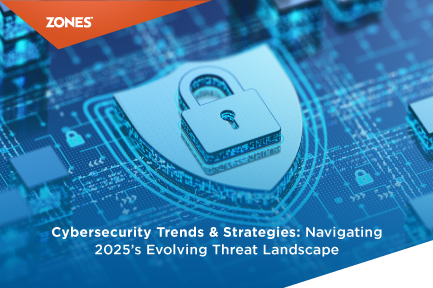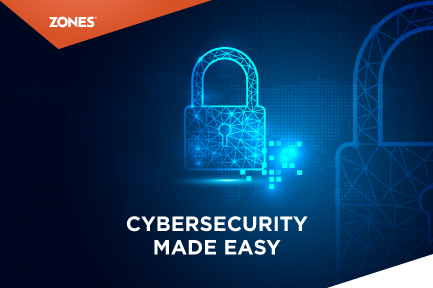Cybersecurity Best Practices to Protect Your Businesses in 2025
Cybercrime is one of the fastest-growing threats worldwide, impacting businesses across all industries. To avoid becoming the next victim of a...
5 min read
![]() Zones
:
Feb 20, 2025 9:32:53 AM
Zones
:
Feb 20, 2025 9:32:53 AM

An evolving threat environment, significant technological advancements, and an increasing reliance on AI-driven security strategies have characterized the cybersecurity landscape 2024. Organizations worldwide have faced complex challenges, including ransomware, AI-driven cyberattacks, and growing compliance pressures.
With cyber threats escalating, businesses are reassessing their security postures and looking ahead to 2025, where emerging technologies and strategic cybersecurity frameworks will define success. This blog provides a comprehensive roundup of 2024 cybersecurity trends, market insights, and forecasts for 2025 while highlighting how Zones Security Services can help organizations navigate the shifting cybersecurity terrain.
Artificial Intelligence (AI) has played a dual role in cybersecurity this year. While organizations leveraged AI for threat detection, automation, and real-time response, cybercriminals also exploited AI-powered attacks, making threats more sophisticated. According to the State of Cybersecurity 2025 report, 47% of organizations identified AI as a driver for cybersecurity action. AI-driven attacks, such as deepfake phishing and automated exploits, surged, highlighting the urgent need for AI-based defenses.
A key takeaway from the 2024 cybersecurity landscape is that AI-powered security tools must evolve faster than cybercriminal tactics. Organizations increasingly invest in AI-driven Managed Extended Detection and Response (MXDR) solutions to enhance security postures.
Ransomware remains a significant cybersecurity concern, with businesses across industries experiencing data encryption attacks and extortion attempts. Ransomware remained one of the most financially damaging threats, but its evolution into cyber extortion presented new challenges. Instead of simply encrypting data, attackers threatened to release sensitive information unless a ransom was paid. A 2024 ransomware study highlighted that involving law enforcement in ransomware cases helped reduce breach costs by nearly $1 million.
A 2024 data breach study revealed that the global average cost of a data breach surged to $4.88 million, a 10% increase from the previous year. This rise was primarily attributed to business disruptions, shadow data (unmanaged data storage), and regulatory penalties. Additionally, breaches involving stolen credentials had an average lifecycle of 292 days, indicating a persistent challenge in identity security.
Companies are now focusing on Zero Trust security frameworks, endpoint protection, and proactive threat-hunting strategies to mitigate the ransomware threat.
As more organizations migrate to the cloud, security concerns have intensified. In 2024, with over 60% of organizations hosting critical workloads in cloud environments, risks such as misconfigurations, insider threats, and API vulnerabilities have surged. The Cisco cybersecurity readiness index indicates that only 4% of companies have a mature cloud security framework, exposing them to risks like supply chain attacks, data leaks, and unauthorized access. The study also found that 54% of organizations experienced a cybersecurity incident in the past year, ranking cloud vulnerabilities among the top attack vectors.
One of the most pressing challenges in 2024 has been the growing shortage of cybersecurity professionals. This issue remained critical, with 470,000 cybersecurity job openings reported in the U.S. alone, underscoring the widening skills gap. Despite 78% of organizations ranking cybersecurity as a high priority, 56% acknowledged facing a moderate to severe shortage of skilled professionals.
This talent deficit has driven organizations to increasingly rely on managed security service providers (MSSPs) to bridge the expertise gap and ensure robust protection against evolving cyber threats. Businesses also invest in automated security operations and cybersecurity upskilling initiatives to compensate for the lack of skilled professionals.
Data privacy regulations continue to shape cybersecurity strategies. In 2024, new compliance mandates such as NIS2 in Europe and updated CISA guidelines in the U.S. pushed organizations to prioritize compliance-driven security investments.
Businesses in regulated industries, particularly healthcare, finance, and government, had to align with evolving standards for incident reporting, encryption, and risk management.
These statistics underscore the increasing focus on cyber resilience, AI-powered security, and managed detection and response (MDR) services.
AI will continue playing a crucial role in 2025, focusing on adaptive cybersecurity frameworks that detect and respond to real-time threats. Behavioral analytics and intelligent threat hunting will become standard features in enterprise security.
Security Operations Centers (SOCs) will integrate AI to enhance threat intelligence, incident response, and automated remediation. AI-driven Extended Detection and Response (XDR) solutions will become the norm, enabling organizations to detect threats faster and reduce response times by over 50%.
With the rapid advancements in quantum computing, organizations will begin transitioning to post-quantum cryptographic algorithms to safeguard sensitive data against future quantum-powered attacks. The NSA and NIST have already recommended migration to quantum-resistant encryption standards to secure sensitive data against future quantum-powered decryption threats.
In 2025, businesses will shift from disjointed security tools to integrated cybersecurity platforms, such as XDR, Security Service Edge (SSE), and AI-powered SOAR solutions. This shift will help reduce operational complexity and improve incident response efficiency.
Identity Intelligence, which includes continuous authentication, behavioral analytics, and password-less solutions, will be crucial as cybercriminals increasingly target identity-based vulnerabilities.
With security complexity rising, Managed Security Services (MSS) will see widespread adoption. Companies will outsource security operations to MSS providers, ensuring continuous monitoring, compliance management, and rapid incident response.
Stricter data protection laws like the EU’s AI Act and the SEC’s cybersecurity disclosure rules will push organizations to adopt more transparent and auditable cybersecurity frameworks. Non-compliance will lead to increased legal and financial repercussions.
Given the skills shortage and increasing complexity of threats, businesses will outsource cybersecurity functions to managed security services providers (MSSPs). This will drive the adoption of Security Operations as a Service (SOCaaS), MXDR (Managed extended Detection and Response), VAPT (Vulnerability Assessment and Penetration Testing), and Continuous Risk Assessment services
The cybersecurity landscape 2025 will demand a proactive, AI-driven, and integrated approach to security. Businesses must prioritize threat intelligence, invest in security automation, and embrace managed security services to stay resilient against sophisticated cyber threats.
As cyber risks continue to evolve, collaborating with experienced security providers like Zones will be essential for building future-proof cybersecurity frameworks that ensure business continuity, compliance, and operational security.
Zones Security Services delivers comprehensive managed security solutions, enabling organizations to combat cyber threats effectively. Our offerings encompass Vulnerability Assessment & Penetration Testing (VAPT) to proactively identify and mitigate security gaps before attackers can exploit them. We also provide in-depth Security Assessments to evaluate security postures, ensuring alignment with compliance and regulatory requirements.
Additionally, our Security Operations as a Service (SOCaaS) MXDR, powered by Microsoft Sentinel, leverages AI-driven threat detection and response capabilities. With 24/7 monitoring, incident response, and forensic analysis, we help organizations strengthen their cyber resilience and maintain a proactive security posture against evolving threats.
Zones Security Services helps organizations stay ahead of evolving threats in 2025 and beyond by integrating proactive threat management, AI-driven automation, and strategic cybersecurity frameworks.
Sources:
https://www.comptia.org/content/research/cybersecurity-trends-research
https://www.sentinelone.com/cybersecurity-101/cybersecurity/cyber-security-trends/
https://go.crowdstrike.com/global-threat-report-2024.html?
https://www.ibm.com/reports/data-breach
https://www.proofpoint.com/us/resources/threat-reports/ponemon-healthcare-cybersecurity-report
https://transform.cisco.com/opsadmin/2024cybersecurityreadinessindex?xs=605654

Cybercrime is one of the fastest-growing threats worldwide, impacting businesses across all industries. To avoid becoming the next victim of a...
.png)
The Multi-Cloud Reality IT Teams Are Navigating Most organizations today operate across more than one cloud, whether by design or through natural...

The Evolving Threat Landscape: Why Security Matters More Than Ever The digital landscape is constantly evolving, and so is the risk to digital...